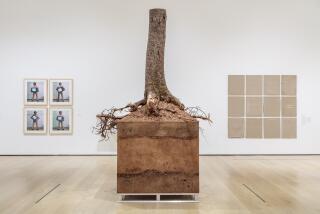âAfter 1968â has a new generation looking back
The year 1968 was a transformative one in American history, marred by the assassinations of Martin Luther King and Robert F. Kennedy, bringing new dimension to the long-running civil rights struggle. âAfter 1968,â a traveling exhibit on view at the California African American Museum in Exposition Park, challenged emerging artists born in or after that fateful year to create projects based on their interpretation of the civil rights period and its influence on future generations.
FOR THE RECORD:
âAfter 1968â: An article last Sunday about the exhibit âAfter 1968â at the California African American Museum in Exposition Park referred to artist Hank Lewis Thomas. His correct middle name is Willis. â
The exhibit, originated by Atlantaâs High Museum of Art, was conceived as a companion to âRoad to Freedom,â a collection of 160 civil rights photographs from 1956 to 1968 on display at the Skirball Center.
âThis show allows a new generation to look back and see what came out of the struggles,â said Charmaine Jefferson, CAAM executive director.
On display are nine mainly installation-based works by eight artists.
Sound artist Nadine Robinson created âCoronation Theme: Organon,â a sculpture of 28 audio speakers stacked to resemble the façade of Ebenezer Baptist Church in Atlanta, where King preached. Wanting to add audio to the piece, she evoked the violent 1963 protest in Birmingham, Ala.âs Kelly Ingram Park, where police confronted demonstrators -- which included hundreds of young children and their parents -- with fire hoses and attack dogs. Unable to find any audio from this time frame, she produced her own audio of moving water and barking dogs to duplicate similar conditions. The Brooklyn native mixed in the sound of a dove and Handelâs Coronation theme to give a heroic, uplifting feeling.
âI wanted to create a memoriam to the victims of the civil rights era yet moving forward with the majestic-ness of a king entering his place in the world,â said Robinson.
With âUnbranded,â New York-based Hank Willis Thomas addresses the role of advertising in African American culture by composing 41 commercial magazine ads, free of text and logos, into one multiple-framed picture. Trend-capturing images were pulled from Wheaties, Viceroy cigarettes, Coca-Cola and Afro Sheen Blowout Creme Relaxer.
âUsing advertising was a means to track blackness from 1968 to 2008,â said Thomas, noting that before 1968 most images in ads were offensive. âIt wasnât until 1968 did advertisers realize that the black community was a viable market.â
The notion of home ownership is represented by another New York artist, Leslie Hewitt, in âGrounded,â a stand-alone stoop of brick steps leading to an imaginary house. âIt reminds me of the Watts riots that burned down a lot of homes,â recalled Jefferson. âDuring this same time period a judge bought a house in Baldwin Hills, causing white people to flee the neighborhood, creating an opportunity for my father to buy us a home.â
âAfter 1968â is part of a joint initiative between the CAAM and the Skirball Center along with a shared third exhibit, âAn Idea Called Tomorrow,â about environmental and social issues of the future.
More to Read
The biggest entertainment stories
Get our big stories about Hollywood, film, television, music, arts, culture and more right in your inbox as soon as they publish.
You may occasionally receive promotional content from the Los Angeles Times.










